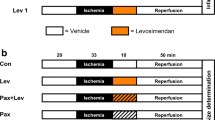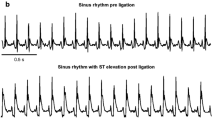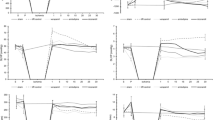Abstract
Action potential duration (APD) shortening due to opening of sarcolemmal ATP-dependent potassium (KATP) channels has been postulated to protect the myocardium against postischemic damage by reducing Ca2+ influx. This hypothesis was assessed, assuming that increased postischemic stunning due to KATP channel inhibition with glibenclamide could be reverted by the addition of the Ca2+ channel blocker diltiazem. Percent wall thickening fraction (% WTh, conscious sheep) and APD (open-chest sheep) were obtained from the following groups: control: 12 min ischemia by anterior descending coronary artery occlusion followed by 2 h reperfusion; glibenclamide: same as control, with glibenclamide (0.4 mg/kg) infused 30 min before ischemia; diltiazem: same as control, with diltiazem (100 μg/kg) administered prior to ischemia; glibenclamide+diltiazem: both drugs infused as in glibenclamide and diltiazem groups. APD was reduced in control ischemia. Conversely, KATP-channel blockade by glibenclamide lengthened APD and increased postischemic stunning (p < 0.01 vs. control); glibenclamide+diltiazem did not shorten APD but enhanced functional recovery (p < 0.01 vs. glibenclamide). Ca2+ channel blockade improvement of increased stunning provoked by KATP channel inhibition supports the hypothesis that APD shortening due to opening of KATP channels protects against postischemic stunning by limiting Ca2+ influx.
Similar content being viewed by others
References
Auchampach JA, Maruyama M, Cavero I, Gross GJ: Pharmacological evidence for a role of ATP-dependent potassium channels in myocardial stunning. Circulation 86: 311–319, 1992
Auchampach JA, Cavero I, Gross GJ: Nicorandil attenuates myocardial dysfunction associated with transient ischemia by opening ATP-dependent potassium channels. J Cardiovasc Pharmac 20: 765–771, 1992
Warltier DC, Auchampach JA, Gross GJ: Relationship of severity of myocardial stunning to ATP dependent potassium channel modulation. J Cardiac Surg 8: 279–283, 1993
Auchampach JA, Maruyama M, Cavero I, Gross GJ: The new K+ channel opener aprikalim (RP 52891) reduces experimental infarct size in dogs in the absence of hemodynamic changes. J Pharmacol Exp Ther 259: 961–967, 1991
Gross GJ, Auchampach JA: Blockade of ATP-sensitive potassium channel prevents myocardial preconditioning in dogs. Circ Res 70: 223–233, 1992
Bernardo NL, D'Angelo M, Okubo S, Joy A, Kukreja RC: Delayed ischemic preconditioning is mediated by opening of ATP-sensitive potassium channels in the rabbit heart. Am J Physiol Heart Circ Physiol 276: H1323–H1330, 1999
Kersten JR, Gross GJ, Pagel PS, Warltier DC: Activation of adenosine triphosphate-regulated potassium channels. Mediation of cellular and organ protection. Anesthesiology 88: 495–513, 1998
Vleugels A, Vereecke J, Carmeliet E: Ionic currents during hypoxia in voltage-clamped cat ventricular muscle. Circ Res 47: 501–508, 1980
Wilde AAM, Escande D, Schumacher CA, Thuringer D, Mestre M, Fiolet JWT, Janse MJ: Potassium accumulation in the globally ischemic mammalian heart. A role for the ATP-sensitive potassium channel. Circ Res 67: 835–843, 1990
Cole WC, McPherson CD, Sontag D: ATP-regulated K+ channels protect the myocardium against ischemia/reperfusion damage. Circ Res 69: 571–581, 1991
Noma A: ATP-regulated K+ channels in cardiac muscle. Nature 305: 147–148, 1983
Shigematsu S, Sato T, Abe T, Saikawa T, Sakata T, Arita M: Pharmacological evidence for the persistent activation of ATP-sensitive K+ channels in early phase of reperfusion and its protective role against myocardial stunning. Circulation 92: 2266–2275, 1995
Bolli R, Marban E: Molecular and cellular mechanisms of myocardial stunning. Phys Rev 79: 609–634, 1999
Hampton TG, Amende I, Travers KE, Morgan JP: Intracellular calcium dynamics in mouse model of myocardial stunning. Am J Physiol Heart Circ Physiol 274: H1821–H1827, 1998
Gao WD, Atar D, Liu Y, Perez NG, Murphy AM, Marban E: Role of troponin I proteolysis in the pathogenesis of stunned myocardium. Circ Res 80: 393–399, 1997
Kusuoka H, Koretsune Y, Chacko VP, Weisfeldt ML, Marban E: Excitation-contraction coupling in postischemic myocardium. Does failure of activator Ca2+ transients underlie stunning? Circ Res 66: 1268–1276, 1990
Taylor AL, Golini P, Eckels R, Pator P, Buja M, Willerson JT: Differential enhancement of postischemic segmental systolic thickening by diltiazem. J Am Coll Cardiol 15: 737–747, 1990
Kusuoka H, Porterfield JK, Weisman HF, Weisfeldt ML, Marban E: Pathophysiology and pathogenesis of stunned myocardium. Depressed Ca2+ activation of contraction as a consequence of reperfusion-induced cellular calcium overload in ferret hearts. J Clin Invest 79: 950–961, 1987
Shine KI, Douglas AM: Low calcium reperfusion of ischemic myocardium. J Mol Cell Cardiol 15: 251–260, 1983
Kitakaze M, Weisfeldt ML, Marban E: Acidosis during early reperfusion prevents myocardial stunning in perfused ferret hearts. J Clin Invest 82: 920–927, 1988
Carrozza JP, Bentivegna LA, Williams CP, Kuntz RE, Grossman W, Morgan JP: Decreased myofilament responsiveness in myocardial stunning follows transient calcium overload during ischemia and reperfusion. Circ Res 71: 1334–1340, 1992
Del Valle HF, Lascano EC, Negroni JA, Crottogini AJ: Glibenclamide effects on reperfusion-induced malignant arrhythmias and left ventricular mechanical recovery from stunning in conscious sheep. Cardiovasc Res 50: 474–485, 2001
Negroni JA, Lascano EC, del Valle HF, Crottogini AJ: ATP-sensitive potassium channels do not have a main role in mediating late preconditioning protection against arrhythmias and stunning in conscious sheep. Basic Res Cardiol 97: 55–64, 2002
Lascano EC, Negroni JA, del Valle HF, Crottogini AJ: Left ventricular systolic and diastolic function in conscious sheep undergoing ischemic preconditioning. Cardiovasc Res 41: 77–86, 1999
Kowallik P, Schulz R, Guth BD, Schade A, Paffhausen W, Gross R, Heusch G: Measurement of regional myocardial blood flow with multiple coloured microspheres. Circulation 83: 974–982, 1991
Schaper W: Coronary occlusion in mammals. In: D.A.K. Black (ed), Clinical Studies, Vol. 1: The Collateral Circulation of the Heart. Amsterdam, North-Holland, 1971, pp 19–28
Meyns BP, Nishimura Y, Jashari R, Racz R, Leunens VH, Flameng WJ: Ascending versus descending aortic balloon pumping: Organ and myocardial perfusion during ischemia. Ann Thorac Surg 70: 1264–1269, 2000
Chien KR, Reeves JP, Buja LM, Bonte F, Parkey RW, Willerson JT: Phospholipid alterations in canine myocardium. Temporal and topographical correlations with Tc-99–PPi accumulation and an in vitro sarcolemmal Ca++ permeability defect. Circ Res 48: 711–719, 1981
Kimura Y, Engelman RM, Rousou J, Flack J, Iyengar J, Das DK: Moderation of myocardial ischemia reperfusion injury by calcium channel and calmodulin receptor inhibition. Heart Vessels 7: 189–195, 1992
Watts JA, Maiorano LJ, Maiorano PC: Comparison of the protective effects of verapamil, diltiazem, nifedipine, and buffer containing low calcium upon global myocardial ischemic injury. J Mol Cell Cardiol 18: 255–263, 1986
Linz KW, Meyer R: Modulation of L-type calcium current by internal potassium in guinea pig ventricular myocytes. Cardiovasc Res 33: 110–122, 1997
Volk T, Nguyen TH, Schultz JH, Ehmke H: Relationship between transient outward K+ current and Ca2+ influx in rat cardiac myocytes of endo-and epicardial origin. J Physiol 519: 841–850, 1999
Kaprielian R, Wickenden AD, Kassiri Z, Parker TG, Liu PP, Backx PH: Relationship between K+ channels down-regulation and [Ca2+]i in rat ventricular myocytes following myocardial infarction. J Physiol 517: 229–245, 1999
Sato T, Sasaki N, Seharaseyon J, O'Rourke B, Marbán E: Selective pharmacological agents implicate mitochondrial but not sarcolemmal KATP channels in ischemic cardioprotection. Circulation 101: 2418–2423, 2000
Ockaili R, Emani VR, Okubo S, Brown M, Krottapalli K, Kukreja RC: Opening of mitochondrial KATP channel induces early and delayed cardioprotective effect: Role of nitric oxide. Am J Physiol 277: H2425–2434, 1999
Grover GJ, Garlid KD: ATP-sensitive potassium channels: A review of their cardioprotective pharmacology. J Mol Cell Cardiol 32: 677–695, 2000
Sargent CA, Smith MA, Dzwonczyk S, Sleph PG, Grover GJ: Effect of potassium channel blockade on the anti-ischemic actions of mechanistically diverse agents. J Pharmacol Exp Ther 259: 97–103, 1991
Thornton JD, Thornton CS, Sterling DL, Downey JM: Blockade of ATP-sensitive potassium channels increases infarct size but does not prevent preconditioning in rabbit hearts. Circ Res 72: 44–49, 1993
Schaffer SW, Tan BH, Mozaffari MS: Effect of glyburide on myocardial metabolism and function. Am J Med 79 (suppl 3B): 48–52, 1985
Du Toit EF, Opie LH: Modulation of severity of reperfusion stunning in the isolated rat heart by agents altering calcium flux at onset of reperfusion. Circ Res 70: 960–967, 1992
Singh BN, Opie LH: Calcium-antagonists. In: L.H Opie (ed), Drugs for the Heart. Orlando, FL, Grune & Stratton, 1984, pp 39–64
Nagao T, Matlib MA, Franklin D, Millard RW, Schwartz A: Effects of diltiazem, a calcium antagonist, on regional myocardial function and mitochondria after brief coronary occlusion. J Mol Cell Cardiol 12: 29–43, 1980
Matsuzaki M, Gallagher KP, Patritti J, Tajimi T, Kemper WS, White FC, Ross J Jr: Effects of a calcium-entry blocker (diltiazem) on regional myocardial flow and function during exercise in conscious dogs. Circulation 69: 801–814, 1984
Kim MS, Akera T: O2 free radicals cause ischemia-reperfusion injury to cardiac Na+-K+-ATPase. Am J Physiol Heart Circ Physiol 252: H252–H257, 1987
Krause SM, Jacobus WE, Becker LC: Alterations in cardiac sarcoplasmic reticulum calcium transport in the postischemic ‘stunned’ myocardium. Circ Res 65: 526–530, 1989
Grinwald PM: Calcium uptake during postischemic reperfusion in the isolated rat heart: Influence of extracellular sodium. J Mol Cell Cardiol 14: 359–365, 1982
Author information
Authors and Affiliations
Rights and permissions
About this article
Cite this article
Lascano, E.C., Negroni, J.A. & del Valle, H.F. Ischemic shortening of action potential duration as a result of KATP channel opening attenuates myocardial stunning by reducing calcium influx. Mol Cell Biochem 236, 53–61 (2002). https://doi.org/10.1023/A:1016198011919
Issue Date:
DOI: https://doi.org/10.1023/A:1016198011919




